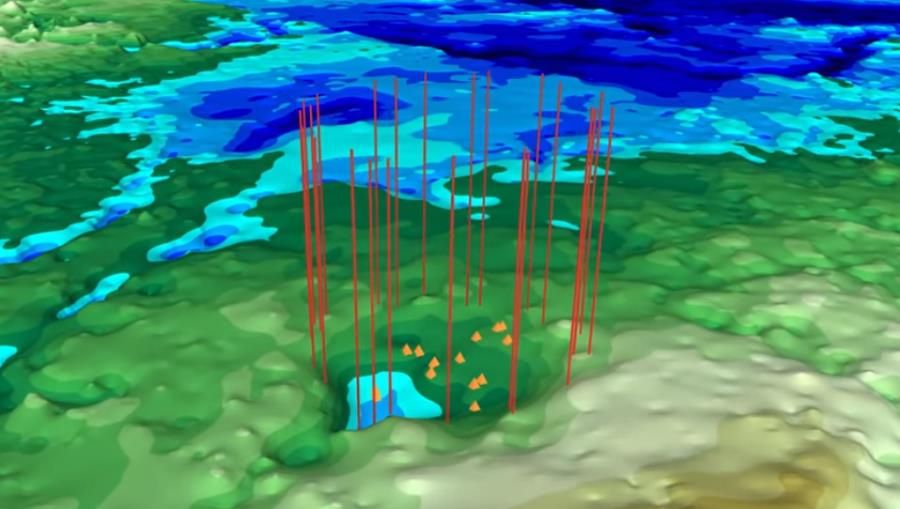
A second impact crater under Greenland’s ice was discovered
A NASA glaciologist has discovered a giant structure under Greenland’s ice, which is most likely an impact crater. Interestingly, late last year another crater was found buried under a thick layer of ice on this island. Scientists believe, however, that both structures were not created by the same event.
Last November, researchers reported finding a large impact crater after Greenland’s ice sheet. Structure with a diameter of more than 30 kilometersow and depths of about 300 metersow is hidden under the Hiawatha glacier in ponorthwestern part of the island. Now NASA scientists report a second impact crater located in Greenland.
The two craters are separated by a distance of more than 180 kilometersow, but scientists say they are unlikely to have formed at the same time. The newly discovered crater has a diameter of more than 35 kilometersoin, ranking it 22nd among theod largest crateroIn the impact crater located on Earth. On the first is the Vredefort crater in South Africa, whichorego outer ring is about 300 kilometers longoin diameter.
– We have surveyed the Earth for many rotion of theow – from the land surface, from the air and even from space. It is exciting that such discoveries are still possible, said Joe MacGregor, a glaciologist at NASA Goddard Space Flight Center. MacGregor was part of a group of scientistsoin, whichora has discovered the first impact crater in Greenland. Now participating in research work on a second structure hidden under the ice.
Before the discovery of the first impact crater under the Hiawatha glacier, scientists believed that most of the evidenceoin past impacts in Greenland and Antarctica have been destroyed by relentless glacial erosion – mechanical processes occurring in the substrate beneath the glacier under the influence of moving ice masses. After finding the first crater, MacGregor checked topographic maps of the rock under Greenland’s ice for a trace of theoin the other craterow. Using surface images taken from satelliteoTerra and Aqua spotted an impact crater-like structure to the southeastod from Hiawatha Glacier. The same circular patternoThe r also appeared in imagery derived from ArcticDEM – commercial satellite imagery.
– I began to wonder if this was another impact crater? Do they read the data correctly? Locating one large impact crater under the ice was already very exciting, but it looked like there were two – MacGregor said.
To confirm his suspicions, MacGregor carefully examined radar images, ktore are used to map the topography of the bedrock under the ice, including those collected by NASA’s Operation IceBridge. What he saw beneath the ice were several characteristics of a complex impact crater: a flat bowl-shaped depression in the bedrock surrounded by an elevated rim and with an uplift in the center. Although the structure is not as circular as Hiawatha crater, MacGregor estimated the diameter of the second crater at nearly 37 kilometersow. Measurements from Operation IceBridge have revealed roalso a negative gravitational anomaly in the area, ktora is characteristic of crateroin impact.
– The only other circular structure, whichora could approach this size, there would be a collapsed volcanic caldera,” said MacGregor. – But areas of known volcanic activity in Greenland are hundreds of kilometers awayow. The volcano should also have a clear positive magnetic anomaly, and this is not visible – added.
Although the newly discovered impact craters in Greenland are only 180 kilometers apartoin from each other, they do not appear to have formed at the same time. Based on the same radar data and ice cores collected near the craterow, MacGregor and his colleagues determined that lod in the area are at least 79,000 years old. The ice layers in the images were smooth, suggesting that for this period lod was not strongly interfered withocany. This means that either the impact happened more than 79,000 years ago, or, if it occurred more recently – ice layers of the plantocone impact has long since flowed out of the area and has been replaced by ice from inland.
– The ice layers over the second crater are clearly older than those on Hiawatha Crater. The second crater also appears to be much more affected by erosion processes – admitted MacGregor. Although it seems unlikely that two craters lying close to each other were created by unrelated events, such a possibility cannot be ruled out. Such a crater pairsow – Geographically close, but by rothat time of the uprising – are located in Ukraine and Canada.
– We appear to have found a third pair of unrelated cratersoin closely located. It’s surprising, but the evidence we’ve collected indicates that this new structure is not a twin of the Hiawatha crater – explained MacGregor.


